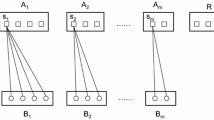Abstract
We consider the Geometric Connected Facility Location Problem (GCFLP): given a set of clients \(\mathcal {C} \subset \mathbb {R}^{d}\), one wants to select a set of locations \(F \subset \mathbb {R}^{d}\) where to open facilities, each at a fixed cost f≥0. For each client \(j \in \mathcal {C}\), one has to choose to either connect it to an open facility ϕ(j)∈F paying the Euclidean distance between j and ϕ(j), or pay a given penalty cost π(j). The facilities must also be connected by a tree T, whose cost is M ℓ(T), where M≥1 and ℓ(T) is the total Euclidean length of edges in T. The multiplication by M reflects the fact that interconnecting two facilities is typically more expensive than connecting a client to a facility. The objective is to find a solution with minimum cost. In this paper, we present a Polynomial-Time Approximation Scheme (PTAS) for the two-dimensional GCFLP. Our algorithm also leads to a PTAS for the two-dimensional Geometric Connected k-medians, when f=0, but only k facilities may be opened.




Similar content being viewed by others
Notes
That is, the vertex \((j,i^{\prime }) \in \mathcal {V}\) that represents the connected component \(i^{\prime }\) of G j is part of connected component i of G.
References
Arora, S.: Polynomial Time Approximation Schemes for Euclidean Traveling Salesman and Other Geometric Problems. J. ACM 45(5), 753–782 (1998). doi:10.1145/290179.290180
Arora, S., Raghavan, P., Rao, S.: Approximation Schemes for Euclidean K-medians and Related Problems. In: Proc.of the 30th Annual ACM Symposium on Theory of Computing, pp. 106–113. ACM. doi:10.1145/276698.276718(1998)
Bateni, M., Hajiaghayi, M.: Euclidean Prize-Collecting Steiner Forest. Algorithmica 62(3-4), 906–929 (2012). doi:10.1007/s00453-011-9491-8
Borradaile, G., Klein, P.N., Mathieu, C.: A Polynomial-Time Approximation Scheme for Euclidean Steiner Forest. ACM Trans. Algorithm. 11(3), 19:1–19:20 (2015). doi:10.1145/2629654
Das, A., Mathieu, C.: A Quasi-Polynomial Time Approximation Scheme for Euclidean Capacitated Vehicle Routing. In: Proc.Of the 21St Annual ACM-SIAM Symposium on Discrete Algorithms, pp. 390–403 (2010)
Du, D.Z., Hwang, F.: A proof of the Gilbert-Pollak conjecture on the Steiner ratio. Algorithmica 7(1-6), 121–135 (1992). doi:10.1007/BF01758755
Garey, M.R., Johnson, D.S.: Computers and Intractability: A Guide to the Theory of NP-completeness. W. H. Freeman (1979)
Gilbert, E.N., Pollak, H.O.: Steiner minimal trees. SIAM J. Appl. Math. 16(1), 1–29 (1968). doi:10.1137/0116001
Goemans, M.X., Williamson, D.P.: A General Approximation Technique for Constrained Forest Problems. SIAM J. Comput. 24(2), 296–317 (1995). doi:10.1137/S0097539793242618
Gupta, A., Kleinberg, J., Kumar, A., Rastogi, R., Yener, B.: Provisioning a Virtual Private Network: A Network Design Problem for Multicommodity Flow. In: Proc.of the 33th Annual ACM Symposium on Theory of Computing, pp. 389–398. doi:10.1145/380752.380830 (2001)
Karloff, H.J.: How Long Can a Euclidean Traveling Salesman Tour Be? SIAM J. Discret. Math. 2(1), 91–99 (1989). doi:10.1137/0402010
Kolliopoulos, S.G., Rao, S.: A Nearly Linear-Time Approximation Scheme for the Euclidean k-Median Problem. SIAM J. Comput. 37(3), 757–782 (2007). doi:10.1137/S0097539702404055
Meira, L.A.A., Miyazawa, F.K.: A Continuous Facility Location Problem and Its Application to a Clustering Problem. In: Proc.Of the 2008 ACM Symposium on Applied Computing. pp. 1826–1831 (2008)
Mitchell, J.S.B.: Guillotine Subdivisions Approximate Polygonal Subdivisions: A Simple Polynomial-Time Approximation Scheme for Geometric TSP, k-MST, and Related Problems. SIAM J. Comput. 28(4), 1298–1309 (1999). doi:10.1137/S0097539796309764
Remy, J., Steger, A.: Approximation Schemes for Node-Weighted Geometric Steiner Tree Problems. Algorithmica 55(1), 240–267 (2007). doi:10.1007/s00453-007-9114-6
Shmoys, D.B., Tardos, E., Aardal, K.: Approximation Algorithms for Facility Location Problems (Extended Abstract). In: Proc.of the 39th Annual ACM Symposium on Theory of Computing. pp. 265–274. doi:10.1145/258533.258600(1997)
Swamy, C., Kumar, A.: Primal-Dual Algorithms for Connected Facility Location Problems. Algorithmica 40(4), 245–269 (2004). doi:10.1007/s00453-004-1112-3
Author information
Authors and Affiliations
Corresponding author
Additional information
This work was partially supported by grants 2013/21744-8 , 2014/14209-1 and 2013/21744-8, São Paulo Research Foundation (FAPESP) and grants 311499/2014-7 and 477692/2012-5, National Council for Scientific and Technological Development (CNPq).
Rights and permissions
About this article
Cite this article
Miyazawa, F.K., C. Pedrosa, L.L., S. Schouery, R.C. et al. A PTAS for the Geometric Connected Facility Location Problem. Theory Comput Syst 61, 871–892 (2017). https://doi.org/10.1007/s00224-017-9749-x
Published:
Issue Date:
DOI: https://doi.org/10.1007/s00224-017-9749-x




